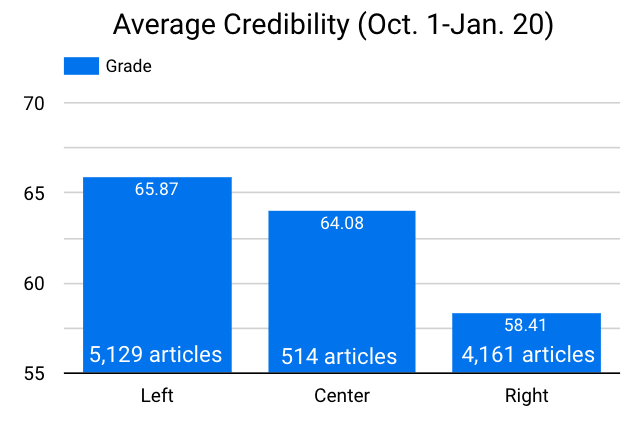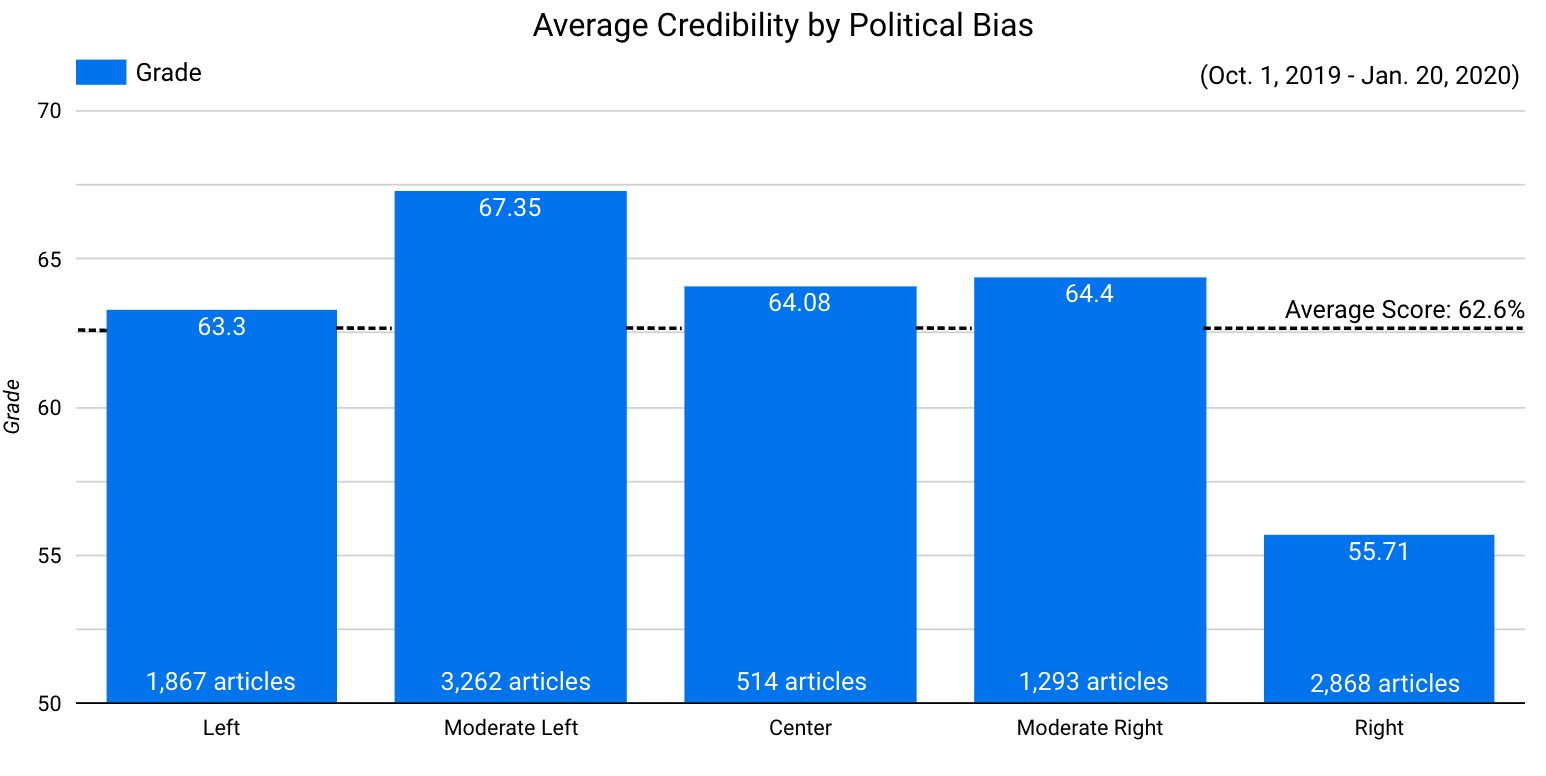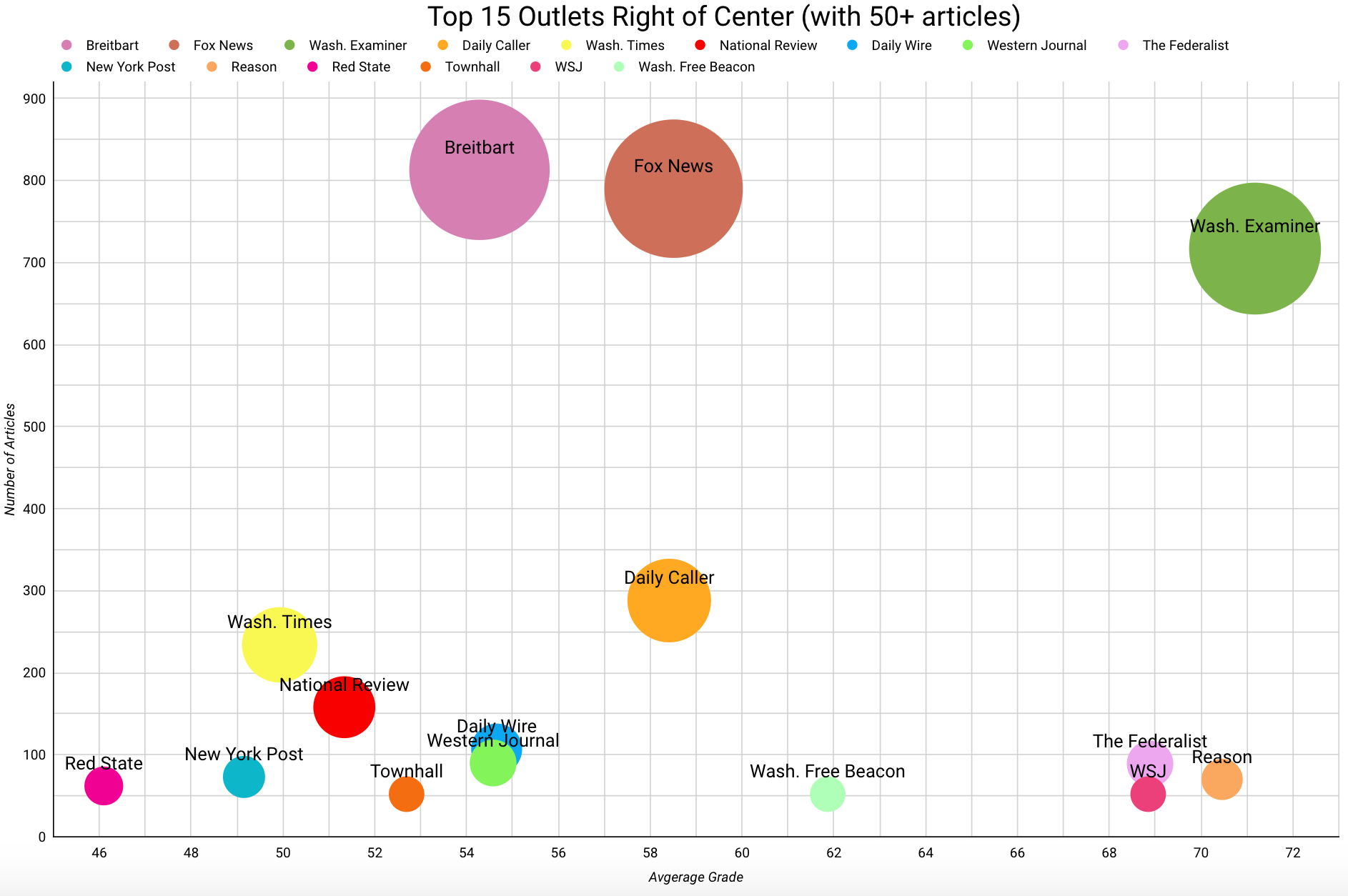There are no two ways to say this: articles from outlets with a Right-leaning political orientation tend to have less credible coverage of the 2020 Democratic presidential candidates. But before you conclude that this proves a liberal bias in The Factual’s credibility algorithm, it is worth looking at our data in greater detail. The story, much like the U.S. political landscape, is far more complex than these first impressions.
Finding credible perspectives across the political spectrum isn’t some idealistic goal. Take this week’s tension over the sentencing of Roger Stone. Articles from the Left argued that Secretary Barr was seeking to appease Trump, while some articles on the Right highlighted that the suggested 7 to 9 year sentencing for a 67-year-old man was high for a non-violent crime. Adopting one side’s viewpoint while missing valid points made by the other side leaves one with a skewed interpretation. You need both sides to get the full picture and see why the country is so divided when it comes to news.
This is true of the broader media environment, too.
 In my first article, I highlighted that news articles about the 2020 Democratic candidates rated by The Factual’s credibility algorithm scored an average of just 62.6%, meaning the average article is only 62.6% likely to be factual. If you break that average down further, outlets left of center score above the average, at 65.9%, and outlets right of center score below the average, at 58.4%. That’s a hefty margin, and the implications such a difference could have on the media environment, especially on the election season, are important.
In my first article, I highlighted that news articles about the 2020 Democratic candidates rated by The Factual’s credibility algorithm scored an average of just 62.6%, meaning the average article is only 62.6% likely to be factual. If you break that average down further, outlets left of center score above the average, at 65.9%, and outlets right of center score below the average, at 58.4%. That’s a hefty margin, and the implications such a difference could have on the media environment, especially on the election season, are important.
But one of the benefits of The Factual’s credibility algorithm is that it helps us capture the reliability of news articles based on a range of factors and classifications. From there we can further break down this trend to see if the data really matches the headline. It turns out everything isn’t so clear cut.
Please check your email for instructions to ensure that the newsletter arrives in your inbox tomorrow.
1. Further Refining the Categories for Political Bias Shows A Different Picture

The answer to our question becomes more complicated if we disaggregate the data into more refined political bias categories (which we have assigned based on AllSides and Media Bias/Fact Check). For example, our data shows that articles from Moderate Right outlets actually tend to score higher (64.4%) than those from Left outlets (63.3%). This broadly suggests that news is more likely to be credible toward the center, not the further one moves left.
Also, looking broadly at these averages can very easily hide the variation within each category. For Moderate Left outlets, scores vary as widely as from Business Insider (75.6%) to Yahoo News (56.3%). Within the Left, the range of variation is even greater (The Intercept – 79.4% to Daily Kos – 46.8%). The takeaway here is that the specific publisher of a news article is far more important than the political leaning from which it comes.
2. Specific News Outlets on the Right Drag Down the Average Score

Note: The Factual is not always able to access all articles from given sites, particularly for websites with paywalls or specialized formatting (e.g., the Wall Street Journal)..
The above is a further illustration that it is the publisher, not the political leaning, that matters when it comes to gauging the reliability of news sources. The graphic above shows the top 15 outlets right of center for which we’ve graded at least 50 articles from the time period. You can see the (mostly distinct) groupings for yourself:
- Right side: four high-scoring outlets, one with a large publication output (Washington Examiner);
- Top Left: two outlets with middling scores but very high output (Breitbart and Fox News); and
- Bottom Left and Center: a number of outlets with lower outputs and low scores.
Statistically speaking, the mass of Breitbart and Fox News articles clustered around the 55-57% goes a long way toward explaining the overall average for Right-leaning articles (58.4%). However, we also see a small but respectable number of outlets that have a decent average score (in fact higher than the average score for Moderate Left), as well as a high number of outlets with averages below 55%.
Also of note, there is a diversity of Right and Moderate Right outlets across the scoring spectrum. Some Right outlets, for example, score higher than or near our overall average (The Federalist – 68.9%; the Washington Free Beacon – 61.9%). Others score particularly low (Red State – 46.1%; National Review – 51.3% and Townhall – 52.7%). Similarly, Moderate Right outlets score anywhere from 71.2% (Washington Examiner) to the second lowest 49.1% (New York Post).
Please check your email for instructions to ensure that the newsletter arrives in your inbox tomorrow.
3. Articles Vary Greatly within Specific Outlets

Useful, well-resourced journalism can come from anywhere. Left-leaning readers may be surprised to see that Fox News produces some highly credible stories. In this sample, the highest and lowest scoring articles from Fox News were separated by 45 points, with 93% of articles scoring between 46% and 69%. Lower scores are most often driven by two factors — more opinionated writing style or fewer links/quotes to back up stated facts — but a complete analysis of this will be in a future post.
The trouble for most readers is evaluating level of opinionatedness, diversity of sources, author expertise and all the other elements of credible news is time consuming. This is why The Factual has a handy Chrome extension to instantly see the credibility of news articles as you browse and a daily newsletter that highlights the most credible stories on the most widely reported news topics.
So if you thought any one political perspective was capable of covering the facts of something as politically charged as Roger Stone’s sentencing, think again. It’s time for all of us to open our doors a little wider and spend less time looking at where articles are coming from and more time at what they are saying.

